|
|
+++ The Three Hierarchs: Saint Basil The Great, Saint Gregory The Theologian And Saint John Chrysostom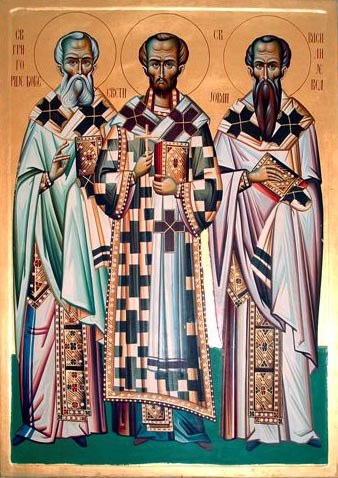 Each of these saints have their own feast day. St. Basil the Great, January 1; St. Gregory the Theologian, January 25; and St. John Chrysostom, January 27. This combined feast day, January 30, was instituted in the eleventh century during the reign of Emperor Alexius Comnenus. At one time a debate arose among the people concerning who of the three is the greatest? Some extolled Basil because of his purity and courage; others extolled Gregory for his unequaled depth and lofty mind in theology; still others extolled Chrysostom because of his eloquence and clarity in expounding the Faith. Thus some were called Basilians, others Gregorgians, and the third were called Johannites. This debate was settled by Divine Providence to the benefit of the Church and to an even greater glory of the three saints. Bishop John of Euchaita (June 14) had a vision in a dream: At first, all three of these saints appeared to him separately in great glory and indescribable beauty, and after that all three appeared together. They said to him, "As you see, we are one in God and there is nothing contradictory in us; neither is there a first or a second among us." The saints also advised Bishop John that he write a common service for them and to order a common feast day of celebration. Following this wonderful vision, the debate was settled in this manner: January 30 would be designated as the common feast of these three hierarchs. The Greeks consider this feast not only an ecclesiastical feast but their greatest national school holiday. Each of these saints have their own feast day. St. Basil the Great, January 1; St. Gregory the Theologian, January 25; and St. John Chrysostom, January 27. This combined feast day, January 30, was instituted in the eleventh century during the reign of Emperor Alexius Comnenus. At one time a debate arose among the people concerning who of the three is the greatest? Some extolled Basil because of his purity and courage; others extolled Gregory for his unequaled depth and lofty mind in theology; still others extolled Chrysostom because of his eloquence and clarity in expounding the Faith. Thus some were called Basilians, others Gregorgians, and the third were called Johannites. This debate was settled by Divine Providence to the benefit of the Church and to an even greater glory of the three saints. Bishop John of Euchaita (June 14) had a vision in a dream: At first, all three of these saints appeared to him separately in great glory and indescribable beauty, and after that all three appeared together. They said to him, "As you see, we are one in God and there is nothing contradictory in us; neither is there a first or a second among us." The saints also advised Bishop John that he write a common service for them and to order a common feast day of celebration. Following this wonderful vision, the debate was settled in this manner: January 30 would be designated as the common feast of these three hierarchs. The Greeks consider this feast not only an ecclesiastical feast but their greatest national school holiday.The Priestly-Martyr Hippolytus, Bishop Of Rome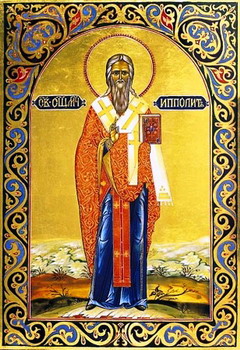 Hippolytus suffered for the Faith during the reign of Claudius. When the virgin Chrysa was unmercifully tortured for Christ in Rome, St. Hippolytus interceded on her behalf before the torturers and denounced them. Because of that protest, Hippolytus also was brought to court, was condemned and, after prolonged tortures, was sentenced to death. They bound his hands and feet and drowned him in the sea. Along with Hippolytus and Chrysa, twenty other martyrs also suffered. St. Hippolytus suffered in the year 269 A.D. Hippolytus suffered for the Faith during the reign of Claudius. When the virgin Chrysa was unmercifully tortured for Christ in Rome, St. Hippolytus interceded on her behalf before the torturers and denounced them. Because of that protest, Hippolytus also was brought to court, was condemned and, after prolonged tortures, was sentenced to death. They bound his hands and feet and drowned him in the sea. Along with Hippolytus and Chrysa, twenty other martyrs also suffered. St. Hippolytus suffered in the year 269 A.D. The Holy Martyr Theophilus The New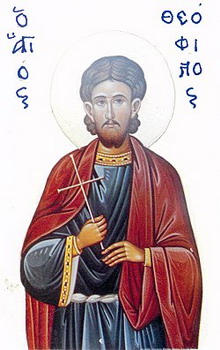 As a commander of the Emperor Constantine and Empress Irene, Theophilus was enslaved by the Hagarites and was kept in prison for four years. When he refused all pressures of the Muslims to abandon the Christian Faith, Theophilus was beheaded in the year 784 A.D. and took up habitation with the Lord. As a commander of the Emperor Constantine and Empress Irene, Theophilus was enslaved by the Hagarites and was kept in prison for four years. When he refused all pressures of the Muslims to abandon the Christian Faith, Theophilus was beheaded in the year 784 A.D. and took up habitation with the Lord.Saint Peter, Tsar Of Bulgaria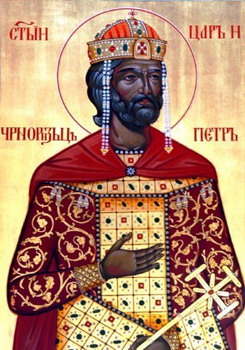 Peter was the son of Simeon who was a great admirer of St. John of Rila. He gained independence for the Bulgarian Church from Constantinople and preserved Orthodoxy in Bulgaria from the Bogomils. After an unsuccessful war with the Hungarians and Russians, Peter died in 967 A.D. in the fifty-sixth year of his life. Peter was the son of Simeon who was a great admirer of St. John of Rila. He gained independence for the Bulgarian Church from Constantinople and preserved Orthodoxy in Bulgaria from the Bogomils. After an unsuccessful war with the Hungarians and Russians, Peter died in 967 A.D. in the fifty-sixth year of his life.New Martyr Theodore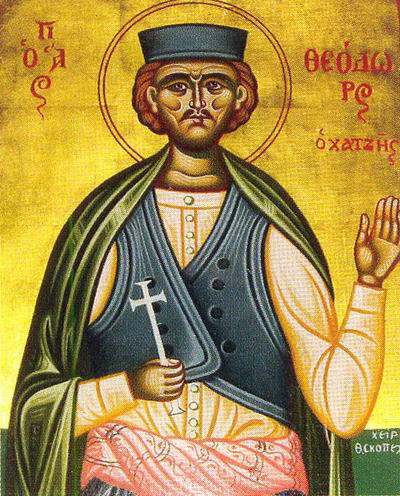 The Holy New Martyr Theodore was born in the city of Mytilene, where he married and raised children in Orthodox piety. He renounced Christ and accepted the Moslem religion, but soon repented of his sin, left his family and went to Mt. Athos. But even in the monastery St Theodore was deeply anguished by his denial of Christ.
The Lord blessed the saint to confess the Orthodox Faith before a Moslem judge in the year 1784. The enraged judge gave orders to fiercely torture the holy martyr, and then they strangled him with a rope and cast him into the sea. Christians buried the body of the holy Martyr Theodore in the church of St John the Forerunner. The Holy New Martyr Theodore was born in the city of Mytilene, where he married and raised children in Orthodox piety. He renounced Christ and accepted the Moslem religion, but soon repented of his sin, left his family and went to Mt. Athos. But even in the monastery St Theodore was deeply anguished by his denial of Christ.
The Lord blessed the saint to confess the Orthodox Faith before a Moslem judge in the year 1784. The enraged judge gave orders to fiercely torture the holy martyr, and then they strangled him with a rope and cast him into the sea. Christians buried the body of the holy Martyr Theodore in the church of St John the Forerunner. Martyrs Censorinus, Sabinus, Chrysia the Virgin and 20 Other Martyrs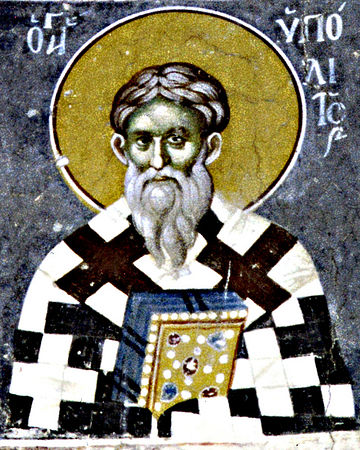 Martyrs Censorinus, Sabinus, Ares (Aares), the virgin Chryse (Chryse of Rome), Felix, Maximus, Herculianus, Venerius, Styracius, Mennas, Commodus, Hermes, Maurus, Eusebius, Rusticus, Monagrius, Amandinus, Olympius, Cyprus, Theodore the Tribune, the priest Maximus, the deacon Archelaus, and the bishop Cyriacus, at Ostia – under Roman Emperor Claudius Gothicus and a vicarius named Ulpius Romulus (269) Martyrs Censorinus, Sabinus, Ares (Aares), the virgin Chryse (Chryse of Rome), Felix, Maximus, Herculianus, Venerius, Styracius, Mennas, Commodus, Hermes, Maurus, Eusebius, Rusticus, Monagrius, Amandinus, Olympius, Cyprus, Theodore the Tribune, the priest Maximus, the deacon Archelaus, and the bishop Cyriacus, at Ostia – under Roman Emperor Claudius Gothicus and a vicarius named Ulpius Romulus (269)Icon of the Mother of God 'Tinos'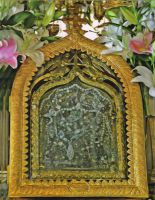 This highly-venerated icon of the Annunciation was discovered in the ruins of the ancient church of St John the Baptist on January 30, 1823.
An elderly man, Michael Polyzoes, had a dream shortly before the Feast of the Annunciation in 1821, in which the Mother of God appeared to him in shining white garments. She instructed him to dig in the field of Anthony Doxaras outside the city, where he would find her icon. She also told him to build a church on the site, since there had once been one there. The Queen of Heaven also promised to help him accomplish these tasks.
Upon awakening, he crossed himself and tried to go back to sleep, believing that his dream had been a temptation from the devil. Before falling asleep, Michael saw the Theotokos once again, and noticed that the room was flooded by a gentle white light. Her head was surrounded by divine light, and her face displayed ineffable grace and sweetness. Speaking to the old man she said, “Why are you afraid? Your fear comes from unbelief. Listen! I am Panagia (the all-holy one). I want you to dig in the field of Anthony Doxaras where my icon is buried. I ask you to do this as a favor, old man. You will build a church there and I will help you.” Then she disappeared.
The next morning, Michael went into the village and told the priest what had happened to him during the night. The priest also thought the dream was a temptation, so he urged Michael to come for Confession and Communion. The old man, however, was not convinced that his visions were mere dreams or demonic temptations. He told the inhabitants of the village of his experience. Some laughed at him, but only two believed his words.
The two men went with him to the field one night and dug in many places, but they found nothing. Then they dug in another place and found the remains of an old wall. Finding nothing but bricks, they had to give up their search in the morning so the Turks would not find out what they were doing.
Anthony Doxaras, the owner of the field, found the bricks and tried to use them to build an oven. The mortar would not adhere to the bricks, so whenever they tried to build one section of the oven, it collapsed. The workers were convinced that God was showing them that the bricks from the ancient church were not to be used for an oven.
St Pelagia (July 23), an eighty-year-old nun, had several dreams in June of 1822 in which the Most Holy Theotokos appeared to her. St Pelagia was living in the women’s monastery of the Dormition on Mt. Kechrovounios, about an hour’s journey from the village. She had lived in the monastery from a young age, and was known for her great virtue and piety.
The Theotokos appeared to her in a dream and ordered her to go to Stamatelos Kangades (a prominent man of the village), and tell him to uncover the church of St John the Baptist in the field of Anthony Doxaras.
Terrified by the vision, Pelagia attributed the dream to her imagination, and she began to pray. She was afraid to tell anyone about her dream, but the following week, the Theotokos appeared to her again, reminding her of her instructions. Still, the nun remained silent and told no one of her vision. The Theotokos appeared a third time, this time with a severe manner. She chastised the nun for her unbelief, saying, “Go and do as I told you. Be obedient.”
St Pelagia woke up in fear and trembling. As she opened her eyes, she saw the same mysterious Woman she had seen while asleep. With a great effort she asked, “Who are you, Lady? Why are you angry with me, and why do you order me to do these things?”
The Woman raised her hand and said, “Proclaim, O earth, glad tidings of great joy” (Megalynarion of the Ninth Ode of the Canon for Matins of the Annunciation).
Understanding at last, the aged nun joyfully exclaimed, “Praise, O heavens, the glory of God” (The next line of the Megalynarion).
At once, she informed the Abbess of her visions, and she also told Stamatelos Kangades. Mr. Kangades, who had been designated by the Theotokos to carry out the excavation of the church, informed Bishop Gabriel of these events. The bishop had already heard of the dream of Michael Polyzoes, and realized that the account of the nun Pelagia agreed with his vision. Bishop Gabriel wrote to all the churches on the island of Tinos, urging them to cooperate in finding the church and the icon.
Excavations began in September of 1822 under the supervision of Mr. Kangades. The foundations of the church of St John, destroyed by Arabs in 1200, were uncovered. An old well was found near the church, but not the holy icon. The money ran out, and so the effort was abandoned.
Once again the Mother of God appeared to St Pelagia, urging that the excavations continue. Bishop Gabriel sent out an appeal for donations to build a new church on the foundations of the old church of St John the Baptist. The new church was built, and was dedicated to St John and to the Life-Giving Fountain.
On January 30, 1823 workers were leveling the ground inside the church in preparation for laying a new stone floor. About noon one of the workers, Emmanuel Matsos, struck a piece of wood with his pickaxe, splitting it down the middle. He looked at one piece of the board and saw that it was burned on one side, while the other side showed traces of paint. As he brushed off the dirt with his hand, he saw that it was an icon. Joining the two pieces of wood together, he crossed himself and venerated the icon.
He called the other workers, who also came and venerated the icon. When the icon was cleaned, it was shown to be an icon of the Annunciation. The split was in the middle of the icon, between the Theotokos and the Archangel Gabriel. Neither figure was damaged, and this was regarded as a miracle.
That same day, the icon was given to Bishop Gabriel, who kissed it and cried out, “Great art Thou, O Lord, and wondrous are Thy works.”
After the finding of the icon, the inabitants of Tinos were filled with zeal to build a magnificent church in honor of the Theotokos. People offered their money and their own labor to help build the church of the Evangelistria (She who received the Good News).
The new church was completed in 1823, and was consecrated by Bishop Gabriel. St Pelagia of Tinos fell asleep in the Lord on April 28, 1834. Her Feast Day, however, is on July 23.
The Tinos Icon of the Most Holy Theotokos continues to be venerated as one of Greece’s holiest treasures. Innumerable miracles of healing and deliverance from danger have not ceased since the time the icon was found. This highly-venerated icon of the Annunciation was discovered in the ruins of the ancient church of St John the Baptist on January 30, 1823.
An elderly man, Michael Polyzoes, had a dream shortly before the Feast of the Annunciation in 1821, in which the Mother of God appeared to him in shining white garments. She instructed him to dig in the field of Anthony Doxaras outside the city, where he would find her icon. She also told him to build a church on the site, since there had once been one there. The Queen of Heaven also promised to help him accomplish these tasks.
Upon awakening, he crossed himself and tried to go back to sleep, believing that his dream had been a temptation from the devil. Before falling asleep, Michael saw the Theotokos once again, and noticed that the room was flooded by a gentle white light. Her head was surrounded by divine light, and her face displayed ineffable grace and sweetness. Speaking to the old man she said, “Why are you afraid? Your fear comes from unbelief. Listen! I am Panagia (the all-holy one). I want you to dig in the field of Anthony Doxaras where my icon is buried. I ask you to do this as a favor, old man. You will build a church there and I will help you.” Then she disappeared.
The next morning, Michael went into the village and told the priest what had happened to him during the night. The priest also thought the dream was a temptation, so he urged Michael to come for Confession and Communion. The old man, however, was not convinced that his visions were mere dreams or demonic temptations. He told the inhabitants of the village of his experience. Some laughed at him, but only two believed his words.
The two men went with him to the field one night and dug in many places, but they found nothing. Then they dug in another place and found the remains of an old wall. Finding nothing but bricks, they had to give up their search in the morning so the Turks would not find out what they were doing.
Anthony Doxaras, the owner of the field, found the bricks and tried to use them to build an oven. The mortar would not adhere to the bricks, so whenever they tried to build one section of the oven, it collapsed. The workers were convinced that God was showing them that the bricks from the ancient church were not to be used for an oven.
St Pelagia (July 23), an eighty-year-old nun, had several dreams in June of 1822 in which the Most Holy Theotokos appeared to her. St Pelagia was living in the women’s monastery of the Dormition on Mt. Kechrovounios, about an hour’s journey from the village. She had lived in the monastery from a young age, and was known for her great virtue and piety.
The Theotokos appeared to her in a dream and ordered her to go to Stamatelos Kangades (a prominent man of the village), and tell him to uncover the church of St John the Baptist in the field of Anthony Doxaras.
Terrified by the vision, Pelagia attributed the dream to her imagination, and she began to pray. She was afraid to tell anyone about her dream, but the following week, the Theotokos appeared to her again, reminding her of her instructions. Still, the nun remained silent and told no one of her vision. The Theotokos appeared a third time, this time with a severe manner. She chastised the nun for her unbelief, saying, “Go and do as I told you. Be obedient.”
St Pelagia woke up in fear and trembling. As she opened her eyes, she saw the same mysterious Woman she had seen while asleep. With a great effort she asked, “Who are you, Lady? Why are you angry with me, and why do you order me to do these things?”
The Woman raised her hand and said, “Proclaim, O earth, glad tidings of great joy” (Megalynarion of the Ninth Ode of the Canon for Matins of the Annunciation).
Understanding at last, the aged nun joyfully exclaimed, “Praise, O heavens, the glory of God” (The next line of the Megalynarion).
At once, she informed the Abbess of her visions, and she also told Stamatelos Kangades. Mr. Kangades, who had been designated by the Theotokos to carry out the excavation of the church, informed Bishop Gabriel of these events. The bishop had already heard of the dream of Michael Polyzoes, and realized that the account of the nun Pelagia agreed with his vision. Bishop Gabriel wrote to all the churches on the island of Tinos, urging them to cooperate in finding the church and the icon.
Excavations began in September of 1822 under the supervision of Mr. Kangades. The foundations of the church of St John, destroyed by Arabs in 1200, were uncovered. An old well was found near the church, but not the holy icon. The money ran out, and so the effort was abandoned.
Once again the Mother of God appeared to St Pelagia, urging that the excavations continue. Bishop Gabriel sent out an appeal for donations to build a new church on the foundations of the old church of St John the Baptist. The new church was built, and was dedicated to St John and to the Life-Giving Fountain.
On January 30, 1823 workers were leveling the ground inside the church in preparation for laying a new stone floor. About noon one of the workers, Emmanuel Matsos, struck a piece of wood with his pickaxe, splitting it down the middle. He looked at one piece of the board and saw that it was burned on one side, while the other side showed traces of paint. As he brushed off the dirt with his hand, he saw that it was an icon. Joining the two pieces of wood together, he crossed himself and venerated the icon.
He called the other workers, who also came and venerated the icon. When the icon was cleaned, it was shown to be an icon of the Annunciation. The split was in the middle of the icon, between the Theotokos and the Archangel Gabriel. Neither figure was damaged, and this was regarded as a miracle.
That same day, the icon was given to Bishop Gabriel, who kissed it and cried out, “Great art Thou, O Lord, and wondrous are Thy works.”
After the finding of the icon, the inabitants of Tinos were filled with zeal to build a magnificent church in honor of the Theotokos. People offered their money and their own labor to help build the church of the Evangelistria (She who received the Good News).
The new church was completed in 1823, and was consecrated by Bishop Gabriel. St Pelagia of Tinos fell asleep in the Lord on April 28, 1834. Her Feast Day, however, is on July 23.
The Tinos Icon of the Most Holy Theotokos continues to be venerated as one of Greece’s holiest treasures. Innumerable miracles of healing and deliverance from danger have not ceased since the time the icon was found. Venerable Zeno the Hermit of Antioch the Disciple of St Basil the Great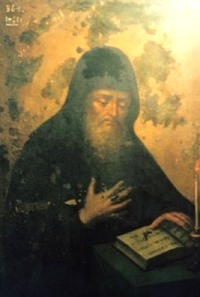 Saint Zeno, the disciple of Saint Basil the Great, was born in the city of Pontus into a rich family. He served at the court of the emperor Valens (364-378), among the soldiers who were sent out to deliver the imperial edicts.
After the death of Valens, St Zeno left the world and settled in a cave near the city of Antioch. For forty years he lived in this cave, and he lived an austere life in complete solitude, cleansing his soul, and meditating on God.
St Zeno went to church each Sunday and received the Holy Mysteries of Christ. In his cell he had neither bed, nor fireplace, nor lamp. The ascetic wore old rags, and ate only bread and water, for which he had to make a tedious journey into the city to the well.
St Zeno was particularly fond of holy books, which he borrowed from those who came to him for spiritual counsel. Through his deep humility the blessed ascetic, filled with the gifts of grace, considered himself poor in spirit. St Zeno died at the beginning of the fifth century. Saint Zeno, the disciple of Saint Basil the Great, was born in the city of Pontus into a rich family. He served at the court of the emperor Valens (364-378), among the soldiers who were sent out to deliver the imperial edicts.
After the death of Valens, St Zeno left the world and settled in a cave near the city of Antioch. For forty years he lived in this cave, and he lived an austere life in complete solitude, cleansing his soul, and meditating on God.
St Zeno went to church each Sunday and received the Holy Mysteries of Christ. In his cell he had neither bed, nor fireplace, nor lamp. The ascetic wore old rags, and ate only bread and water, for which he had to make a tedious journey into the city to the well.
St Zeno was particularly fond of holy books, which he borrowed from those who came to him for spiritual counsel. Through his deep humility the blessed ascetic, filled with the gifts of grace, considered himself poor in spirit. St Zeno died at the beginning of the fifth century. |